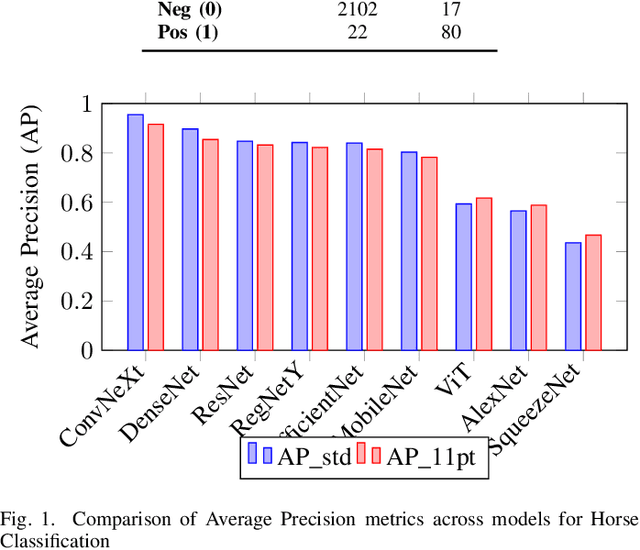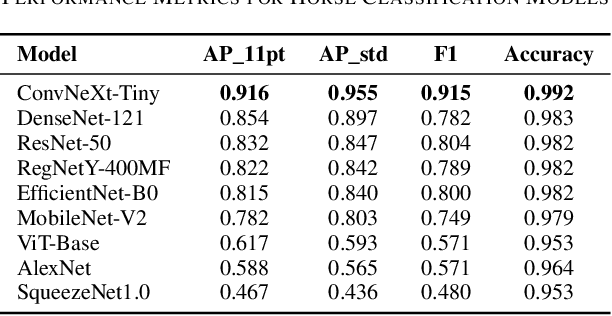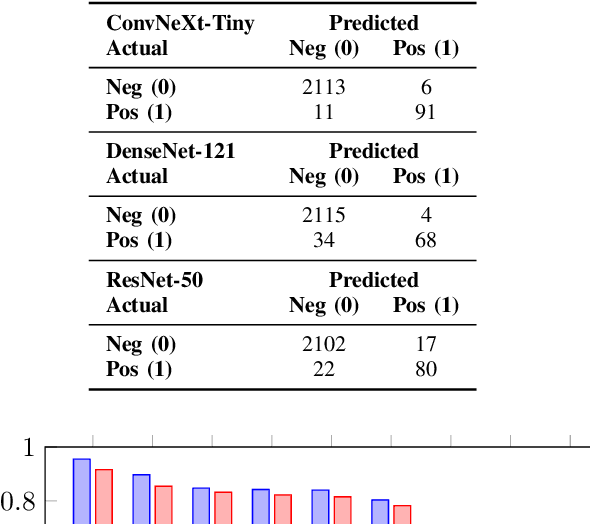Resnet
ResNet (Residual Neural Network) is a deep-learning architecture that uses residual connections to enable training of very deep neural networks.
Papers and Code
Comparative Study of CNN Architectures for Binary Classification of Horses and Motorcycles in the VOC 2008 Dataset
Nov 06, 2025



This paper presents a comprehensive evaluation of nine convolutional neural network architectures for binary classification of horses and motorcycles in the VOC 2008 dataset. We address the significant class imbalance problem by implementing minority-class augmentation techniques. Our experiments compare modern architectures including ResNet-50, ConvNeXt-Tiny, DenseNet-121, and Vision Transformer across multiple performance metrics. Results demonstrate substantial performance variations, with ConvNeXt-Tiny achieving the highest Average Precision (AP) of 95.53% for horse detection and 89.12% for motorcycle detection. We observe that data augmentation significantly improves minority class detection, particularly benefiting deeper architectures. This study provides insights into architecture selection for imbalanced binary classification tasks and quantifies the impact of data augmentation strategies in mitigating class imbalance issues in object detection.
MDM: Manhattan Distance Mapping of DNN Weights for Parasitic-Resistance-Resilient Memristive Crossbars
Nov 06, 2025Manhattan Distance Mapping (MDM) is a post-training deep neural network (DNN) weight mapping technique for memristive bit-sliced compute-in-memory (CIM) crossbars that reduces parasitic resistance (PR) nonidealities. PR limits crossbar efficiency by mapping DNN matrices into small crossbar tiles, reducing CIM-based speedup. Each crossbar executes one tile, requiring digital synchronization before the next layer. At this granularity, designers either deploy many small crossbars in parallel or reuse a few sequentially-both increasing analog-to-digital conversions, latency, I/O pressure, and chip area. MDM alleviates PR effects by optimizing active-memristor placement. Exploiting bit-level structured sparsity, it feeds activations from the denser low-order side and reorders rows according to the Manhattan distance, relocating active cells toward regions less affected by PR and thus lowering the nonideality factor (NF). Applied to DNN models on ImageNet-1k, MDM reduces NF by up to 46% and improves accuracy under analog distortion by an average of 3.6% in ResNets. Overall, it provides a lightweight, spatially informed method for scaling CIM DNN accelerators.
Validating Vision Transformers for Otoscopy: Performance and Data-Leakage Effects
Nov 06, 2025This study evaluates the efficacy of vision transformer models, specifically Swin transformers, in enhancing the diagnostic accuracy of ear diseases compared to traditional convolutional neural networks. With a reported 27% misdiagnosis rate among specialist otolaryngologists, improving diagnostic accuracy is crucial. The research utilised a real-world dataset from the Department of Otolaryngology at the Clinical Hospital of the Universidad de Chile, comprising otoscopic videos of ear examinations depicting various middle and external ear conditions. Frames were selected based on the Laplacian and Shannon entropy thresholds, with blank frames removed. Initially, Swin v1 and Swin v2 transformer models achieved accuracies of 100% and 99.1%, respectively, marginally outperforming the ResNet model (99.5%). These results surpassed metrics reported in related studies. However, the evaluation uncovered a critical data leakage issue in the preprocessing step, affecting both this study and related research using the same raw dataset. After mitigating the data leakage, model performance decreased significantly. Corrected accuracies were 83% for both Swin v1 and Swin v2, and 82% for the ResNet model. This finding highlights the importance of rigorous data handling in machine learning studies, especially in medical applications. The findings indicate that while vision transformers show promise, it is essential to find an optimal balance between the benefits of advanced model architectures and those derived from effective data preprocessing. This balance is key to developing a reliable machine learning model for diagnosing ear diseases.
Distribution-Aware Tensor Decomposition for Compression of Convolutional Neural Networks
Nov 06, 2025Neural networks are widely used for image-related tasks but typically demand considerable computing power. Once a network has been trained, however, its memory- and compute-footprint can be reduced by compression. In this work, we focus on compression through tensorization and low-rank representations. Whereas classical approaches search for a low-rank approximation by minimizing an isotropic norm such as the Frobenius norm in weight-space, we use data-informed norms that measure the error in function space. Concretely, we minimize the change in the layer's output distribution, which can be expressed as $\lVert (W - \widetilde{W}) \Sigma^{1/2}\rVert_F$ where $\Sigma^{1/2}$ is the square root of the covariance matrix of the layer's input and $W$, $\widetilde{W}$ are the original and compressed weights. We propose new alternating least square algorithms for the two most common tensor decompositions (Tucker-2 and CPD) that directly optimize the new norm. Unlike conventional compression pipelines, which almost always require post-compression fine-tuning, our data-informed approach often achieves competitive accuracy without any fine-tuning. We further show that the same covariance-based norm can be transferred from one dataset to another with only a minor accuracy drop, enabling compression even when the original training dataset is unavailable. Experiments on several CNN architectures (ResNet-18/50, and GoogLeNet) and datasets (ImageNet, FGVC-Aircraft, Cifar10, and Cifar100) confirm the advantages of the proposed method.
DP-FedPGN: Finding Global Flat Minima for Differentially Private Federated Learning via Penalizing Gradient Norm
Oct 31, 2025To prevent inference attacks in Federated Learning (FL) and reduce the leakage of sensitive information, Client-level Differentially Private Federated Learning (CL-DPFL) is widely used. However, current CL-DPFL methods usually result in sharper loss landscapes, which leads to a decrease in model generalization after differential privacy protection. By using Sharpness Aware Minimization (SAM), the current popular federated learning methods are to find a local flat minimum value to alleviate this problem. However, the local flatness may not reflect the global flatness in CL-DPFL. Therefore, to address this issue and seek global flat minima of models, we propose a new CL-DPFL algorithm, DP-FedPGN, in which we introduce a global gradient norm penalty to the local loss to find the global flat minimum. Moreover, by using our global gradient norm penalty, we not only find a flatter global minimum but also reduce the locally updated norm, which means that we further reduce the error of gradient clipping. From a theoretical perspective, we analyze how DP-FedPGN mitigates the performance degradation caused by DP. Meanwhile, the proposed DP-FedPGN algorithm eliminates the impact of data heterogeneity and achieves fast convergence. We also use R\'enyi DP to provide strict privacy guarantees and provide sensitivity analysis for local updates. Finally, we conduct effectiveness tests on both ResNet and Transformer models, and achieve significant improvements in six visual and natural language processing tasks compared to existing state-of-the-art algorithms. The code is available at https://github.com/junkangLiu0/DP-FedPGN
On Measuring Localization of Shortcuts in Deep Networks
Oct 30, 2025Shortcuts, spurious rules that perform well during training but fail to generalize, present a major challenge to the reliability of deep networks (Geirhos et al., 2020). However, the impact of shortcuts on feature representations remains understudied, obstructing the design of principled shortcut-mitigation methods. To overcome this limitation, we investigate the layer-wise localization of shortcuts in deep models. Our novel experiment design quantifies the layer-wise contribution to accuracy degradation caused by a shortcut-inducing skew by counterfactual training on clean and skewed datasets. We employ our design to study shortcuts on CIFAR-10, Waterbirds, and CelebA datasets across VGG, ResNet, DeiT, and ConvNeXt architectures. We find that shortcut learning is not localized in specific layers but distributed throughout the network. Different network parts play different roles in this process: shallow layers predominantly encode spurious features, while deeper layers predominantly forget core features that are predictive on clean data. We also analyze the differences in localization and describe its principal axes of variation. Finally, our analysis of layer-wise shortcut-mitigation strategies suggests the hardness of designing general methods, supporting dataset- and architecture-specific approaches instead.
AD-SAM: Fine-Tuning the Segment Anything Vision Foundation Model for Autonomous Driving Perception
Oct 30, 2025This paper presents the Autonomous Driving Segment Anything Model (AD-SAM), a fine-tuned vision foundation model for semantic segmentation in autonomous driving (AD). AD-SAM extends the Segment Anything Model (SAM) with a dual-encoder and deformable decoder tailored to spatial and geometric complexity of road scenes. The dual-encoder produces multi-scale fused representations by combining global semantic context from SAM's pretrained Vision Transformer (ViT-H) with local spatial detail from a trainable convolutional deep learning backbone (i.e., ResNet-50). A deformable fusion module aligns heterogeneous features across scales and object geometries. The decoder performs progressive multi-stage refinement using deformable attention. Training is guided by a hybrid loss that integrates Focal, Dice, Lovasz-Softmax, and Surface losses, improving semantic class balance, boundary precision, and optimization stability. Experiments on the Cityscapes and Berkeley DeepDrive 100K (BDD100K) benchmarks show that AD-SAM surpasses SAM, Generalized SAM (G-SAM), and a deep learning baseline (DeepLabV3) in segmentation accuracy. It achieves 68.1 mean Intersection over Union (mIoU) on Cityscapes and 59.5 mIoU on BDD100K, outperforming SAM, G-SAM, and DeepLabV3 by margins of up to +22.9 and +19.2 mIoU in structured and diverse road scenes, respectively. AD-SAM demonstrates strong cross-domain generalization with a 0.87 retention score (vs. 0.76 for SAM), and faster, more stable learning dynamics, converging within 30-40 epochs, enjoying double the learning speed of benchmark models. It maintains 0.607 mIoU with only 1000 samples, suggesting data efficiency critical for reducing annotation costs. These results confirm that targeted architectural and optimization enhancements to foundation models enable reliable and scalable AD perception.
Bi-Encoder Contrastive Learning for Fingerprint and Iris Biometrics
Oct 27, 2025There has been a historic assumption that the biometrics of an individual are statistically uncorrelated. We test this assumption by training Bi-Encoder networks on three verification tasks, including fingerprint-to-fingerprint matching, iris-to-iris matching, and cross-modal fingerprint-to-iris matching using 274 subjects with $\sim$100k fingerprints and 7k iris images. We trained ResNet-50 and Vision Transformer backbones in Bi-Encoder architectures such that the contrastive loss between images sampled from the same individual is minimized. The iris ResNet architecture reaches 91 ROC AUC score for iris-to-iris matching, providing clear evidence that the left and right irises of an individual are correlated. Fingerprint models reproduce the positive intra-subject suggested by prior work in this space. This is the first work attempting to use Vision Transformers for this matching. Cross-modal matching rises only slightly above chance, which suggests that more data and a more sophisticated pipeline is needed to obtain compelling results. These findings continue challenge independence assumptions of biometrics and we plan to extend this work to other biometrics in the future. Code available: https://github.com/MatthewSo/bio_fingerprints_iris.
Efficient Multi-bit Quantization Network Training via Weight Bias Correction and Bit-wise Coreset Sampling
Oct 23, 2025Multi-bit quantization networks enable flexible deployment of deep neural networks by supporting multiple precision levels within a single model. However, existing approaches suffer from significant training overhead as full-dataset updates are repeated for each supported bit-width, resulting in a cost that scales linearly with the number of precisions. Additionally, extra fine-tuning stages are often required to support additional or intermediate precision options, further compounding the overall training burden. To address this issue, we propose two techniques that greatly reduce the training overhead without compromising model utility: (i) Weight bias correction enables shared batch normalization and eliminates the need for fine-tuning by neutralizing quantization-induced bias across bit-widths and aligning activation distributions; and (ii) Bit-wise coreset sampling strategy allows each child model to train on a compact, informative subset selected via gradient-based importance scores by exploiting the implicit knowledge transfer phenomenon. Experiments on CIFAR-10/100, TinyImageNet, and ImageNet-1K with both ResNet and ViT architectures demonstrate that our method achieves competitive or superior accuracy while reducing training time up to 7.88x. Our code is released at https://github.com/a2jinhee/EMQNet_jk.
HybridSOMSpikeNet: A Deep Model with Differentiable Soft Self-Organizing Maps and Spiking Dynamics for Waste Classification
Oct 23, 2025Accurate waste classification is vital for achieving sustainable waste management and reducing the environmental footprint of urbanization. Misclassification of recyclable materials contributes to landfill accumulation, inefficient recycling, and increased greenhouse gas emissions. To address these issues, this study introduces HybridSOMSpikeNet, a hybrid deep learning framework that integrates convolutional feature extraction, differentiable self-organization, and spiking-inspired temporal processing to enable intelligent and energy-efficient waste classification. The proposed model employs a pre-trained ResNet-152 backbone to extract deep spatial representations, followed by a Differentiable Soft Self-Organizing Map (Soft-SOM) that enhances topological clustering and interpretability. A spiking neural head accumulates temporal activations over discrete time steps, improving robustness and generalization. Trained on a ten-class waste dataset, HybridSOMSpikeNet achieved a test accuracy of 97.39%, outperforming several state-of-the-art architectures while maintaining a lightweight computational profile suitable for real-world deployment. Beyond its technical innovations, the framework provides tangible environmental benefits. By enabling precise and automated waste segregation, it supports higher recycling efficiency, reduces contamination in recyclable streams, and minimizes the ecological and operational costs of waste processing. The approach aligns with global sustainability priorities, particularly the United Nations Sustainable Development Goals (SDG 11 and SDG 12), by contributing to cleaner cities, circular economy initiatives, and intelligent environmental management systems.
 Add to Chrome
Add to Chrome Add to Firefox
Add to Firefox Add to Edge
Add to Edge